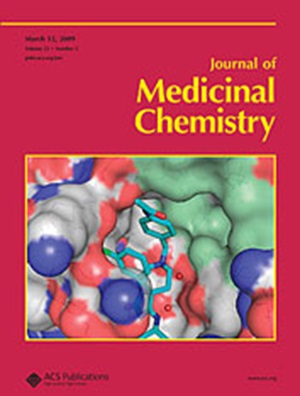新型联苯基有机金(III)配合物的合成及体内外抗癌活性的生物学评价
IF 6.8
1区 医学
Q1 CHEMISTRY, MEDICINAL
引用次数: 0
摘要
尽管最近癌症治疗取得了进展,但仍然需要具有抗肿瘤活性的新型化合物。在通式[(C^C)Au(NHC-pyr)X]中,(C^C) = 4,4′-二叔丁基联苯,X = Cl或苯乙酰基,(NHC-pyr)为吡啶基取代NHC配体的11种联苯基有机金(III) n -杂环卡宾(BGC)配合物中,含有4- cf3 -吡啶基取代基和氯配体的配合物BGC4对三阴性乳腺癌细胞系显示出良好的抗肿瘤活性。BGC4能诱导细胞凋亡,但对细胞周期无影响。在体内,BGC4通过增加坏死面积和降低有丝分裂活性来降低肿瘤生长速度。多次注射BGC4未引起常见的副作用。目前的研究表明,BGC4是一种很有前途的抗肿瘤候选药物。通过评估其与当前化疗联合治疗的疗效,将加强其作为治疗癌症的未来化疗药物的潜力。本文章由计算机程序翻译,如有差异,请以英文原文为准。

Synthesis and Biological Evaluation of a New Biphenyl-Based Organogold(III) Complex with In Vitro and In Vivo Anticancer Activity
Despite recent advances in cancer treatment, there is still a need for novel compounds with antineoplastic activity. Among 11 biphenyl-based organogold(III) N-heterocyclic carbene (NHC) (BGC) complexes of general formula [(C^C)Au(NHC-pyr)X], where (C^C) = 4,4′-ditertbutylbiphenyl, X = Cl or phenylacetylide, and (NHC-pyr) is a pyridyl-substituted NHC ligand, the complex BGC4 bearing a 4-CF3-pyridyl substituent and a chloride ligand showed promising antineoplastic activity on the triple negative breast cancer cell line. BGC4 was able to induce cell apoptosis but had no effect on the cell cycle. In vivo, BGC4 reduced the tumor growth rate by increasing the necrosis area and decreasing the mitotic activity. Repeated injections of BGC4 did not induce common side effects. The present investigation shows that BGC4 is a promising antineoplastic candidate. Its potential as a future chemotherapy for the treatment of cancer will be strengthened by evaluating its efficacy in combined treatment with current chemotherapy.
求助全文
通过发布文献求助,成功后即可免费获取论文全文。
去求助
来源期刊

Journal of Medicinal Chemistry
医学-医药化学
CiteScore
4.00
自引率
11.00%
发文量
804
审稿时长
1.9 months
期刊介绍:
The Journal of Medicinal Chemistry is a prestigious biweekly peer-reviewed publication that focuses on the multifaceted field of medicinal chemistry. Since its inception in 1959 as the Journal of Medicinal and Pharmaceutical Chemistry, it has evolved to become a cornerstone in the dissemination of research findings related to the design, synthesis, and development of therapeutic agents.
The Journal of Medicinal Chemistry is recognized for its significant impact in the scientific community, as evidenced by its 2022 impact factor of 7.3. This metric reflects the journal's influence and the importance of its content in shaping the future of drug discovery and development. The journal serves as a vital resource for chemists, pharmacologists, and other researchers interested in the molecular mechanisms of drug action and the optimization of therapeutic compounds.
 求助内容:
求助内容: 应助结果提醒方式:
应助结果提醒方式:


